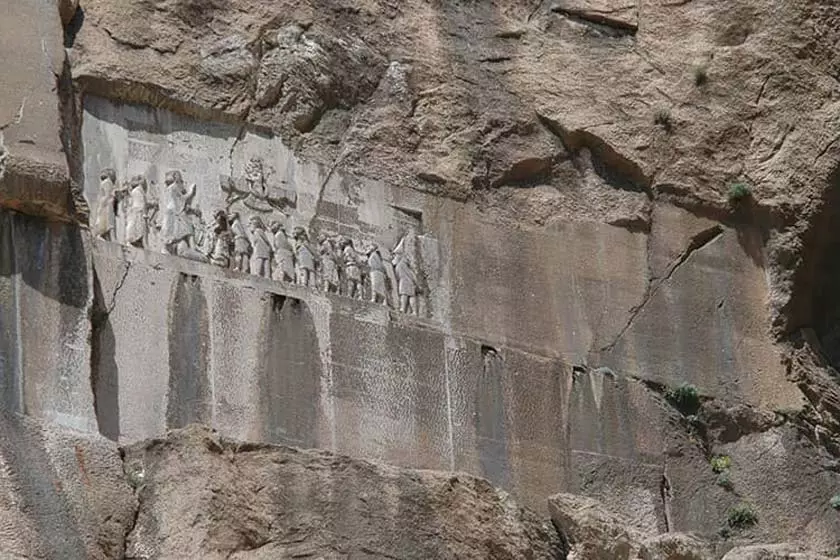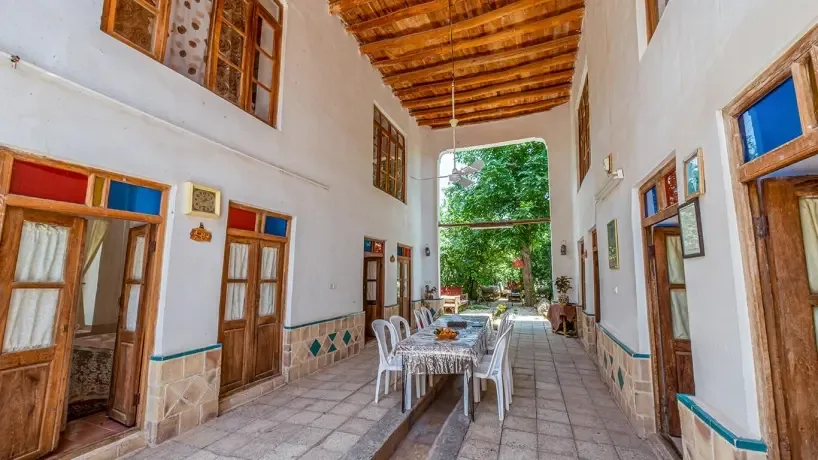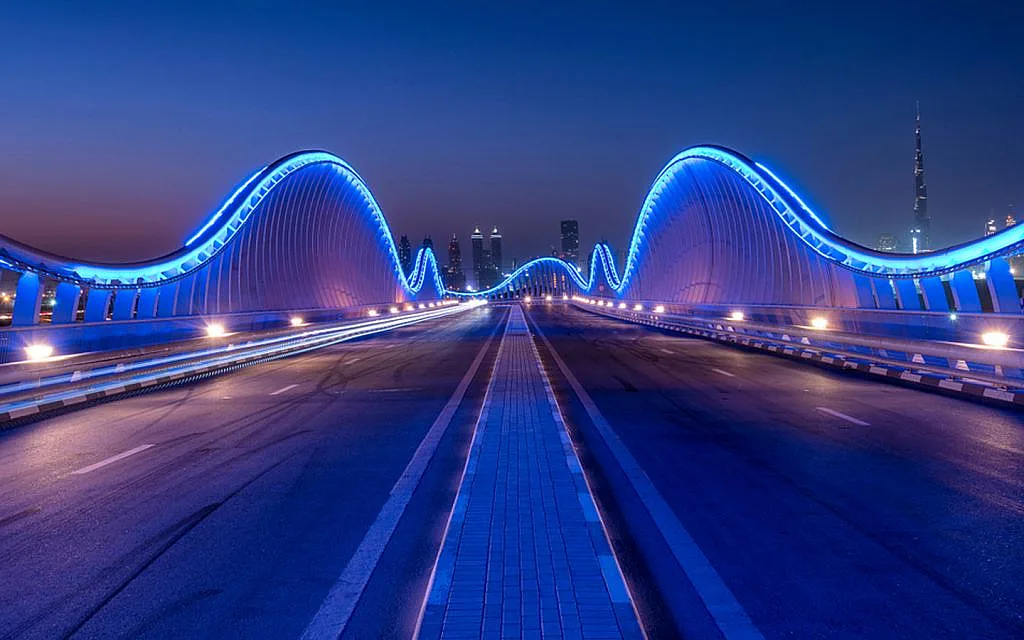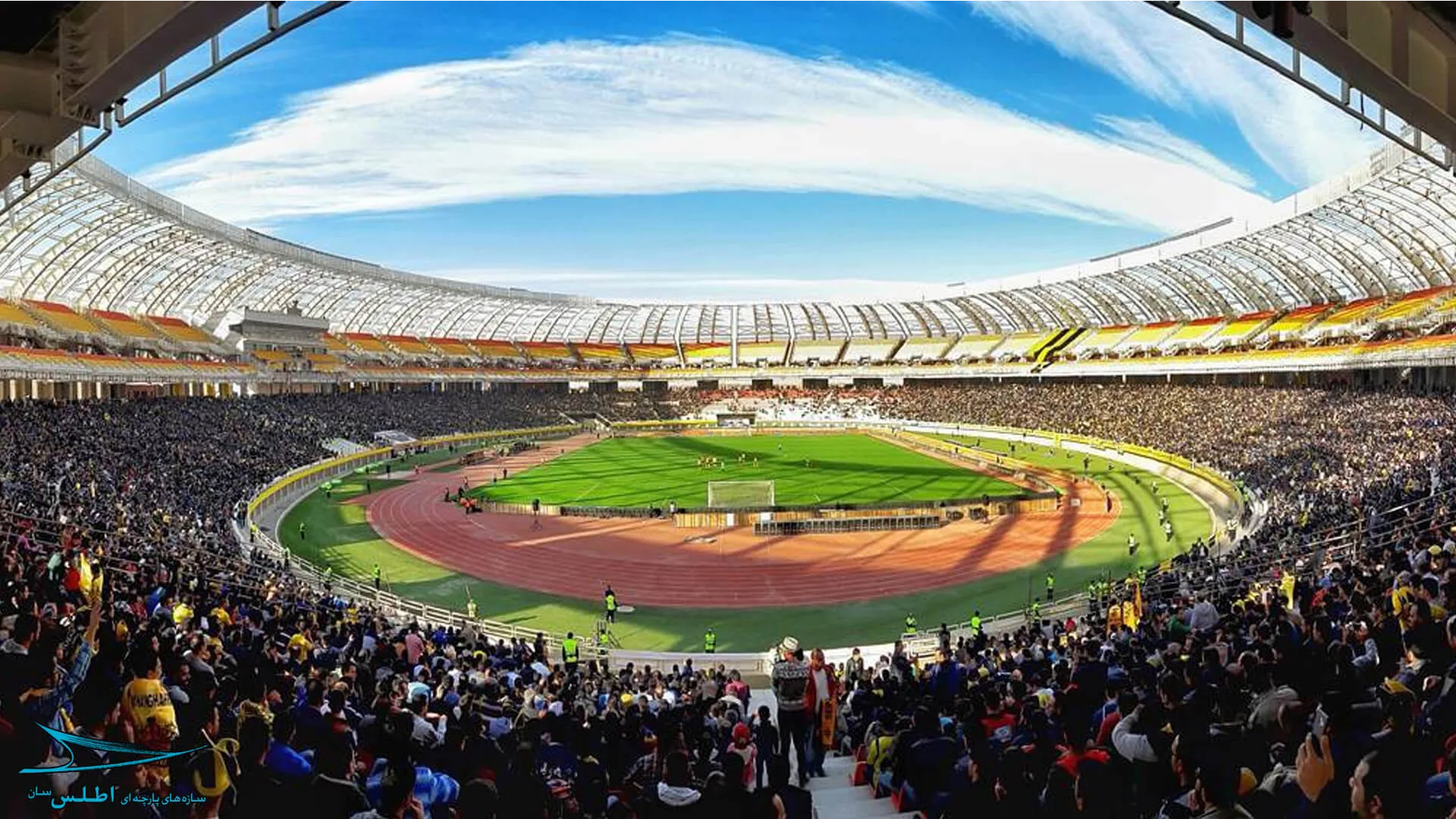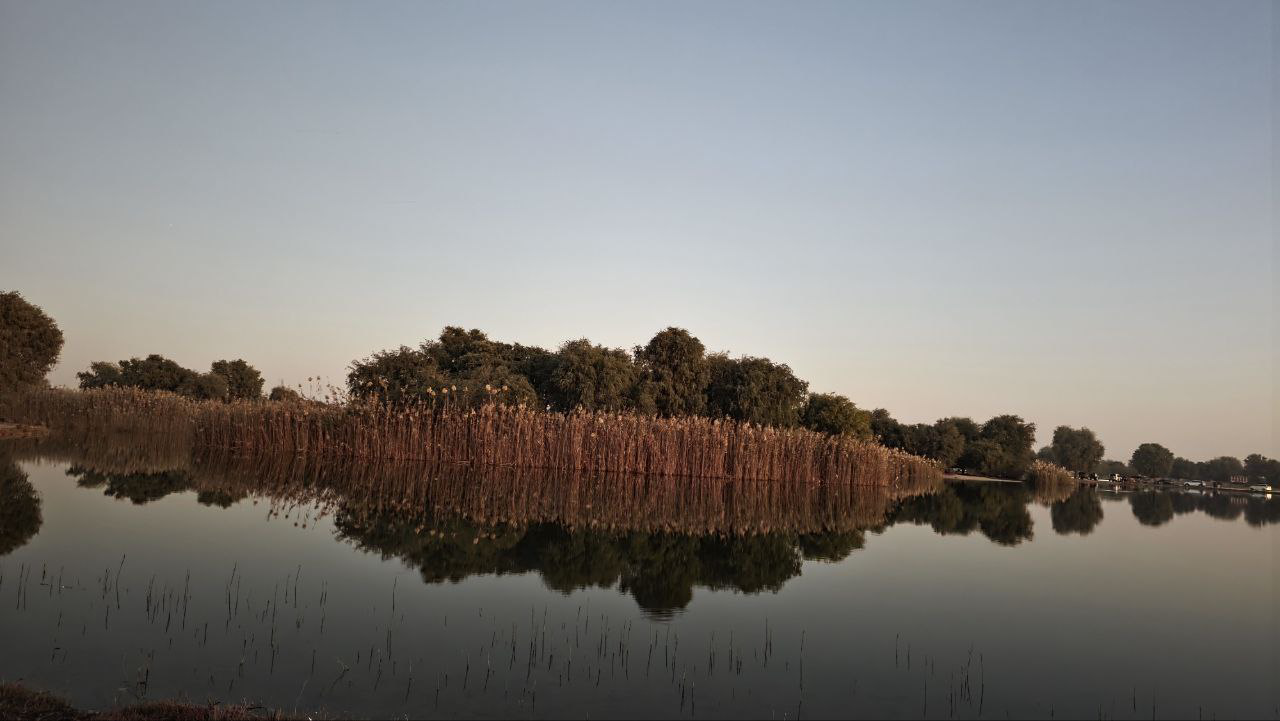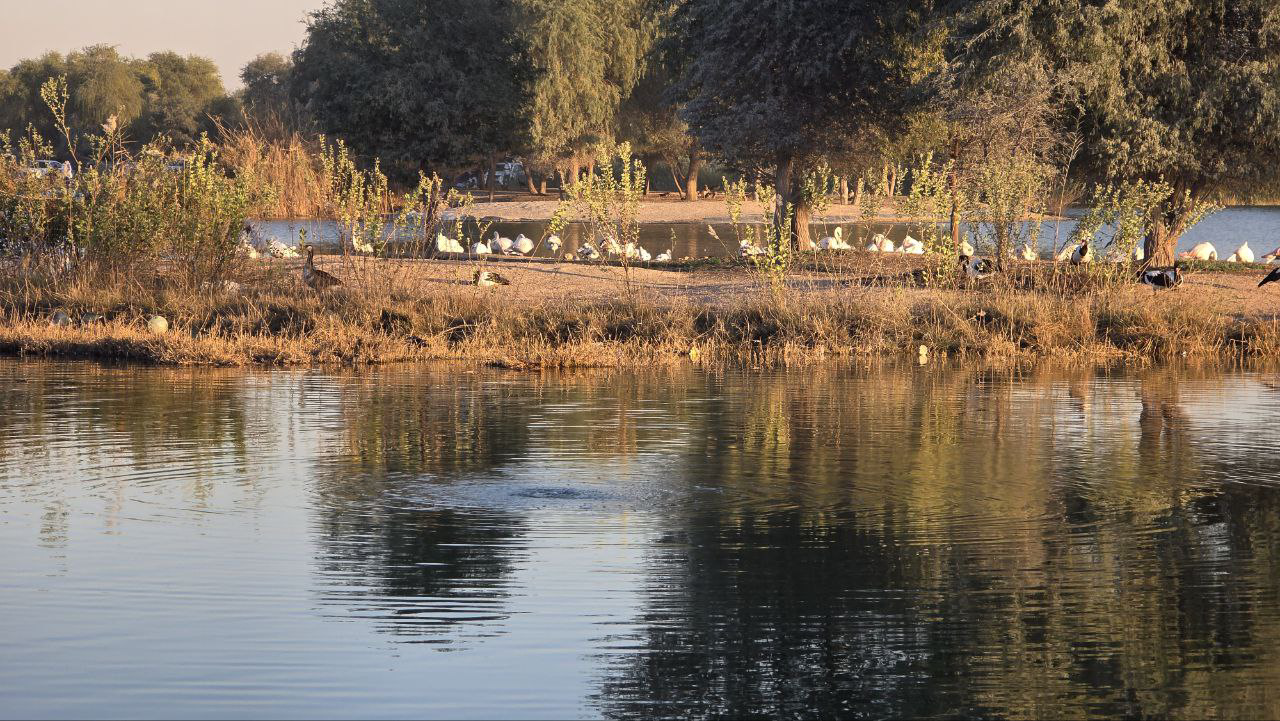Bistun Kermanshah | Bisotun’s Historic Landmarks Revealed
Bisotun, located in Kermanshah, is a renowned historical site in Iran, housing numerous historical treasures such as the Statue of Hercules, Bisotun Bridge, Shah Abbas Caravanserai, the prominent relief of Darius the Great, the Farhad Carving, and more. Consequently, it is considered one of the significant archaeological zones in Iran. One of the notable artifacts within this complex is the inscribed and sculpted rock of Darius, listed as a UNESCO World Heritage Site. Additionally, the presence of numerous caves in the Bisotun mountain bears witness to human habitation in this region during the Paleolithic period.
Bisotun, due to the presence of historical artifacts dating back approximately four thousand years and continuing until several hundred years ago, is regarded as a treasury of Iranian historical artifacts. To date, 28 of its artifacts have been registered as national heritage sites in Iran. Join us for a more in-depth exploration of this complex.
Everything You Need to Know About Bisotun:
Nestled in the foothills of the Zagros Mountains in western Iran, Bisotun (also known as Behistun) is a captivating town brimming with historical significance and natural splendor. Its crown jewel, the Bisotun Inscription, stands as a UNESCO World Heritage Site and a testament to the grandeur of the Achaemenid Empire.
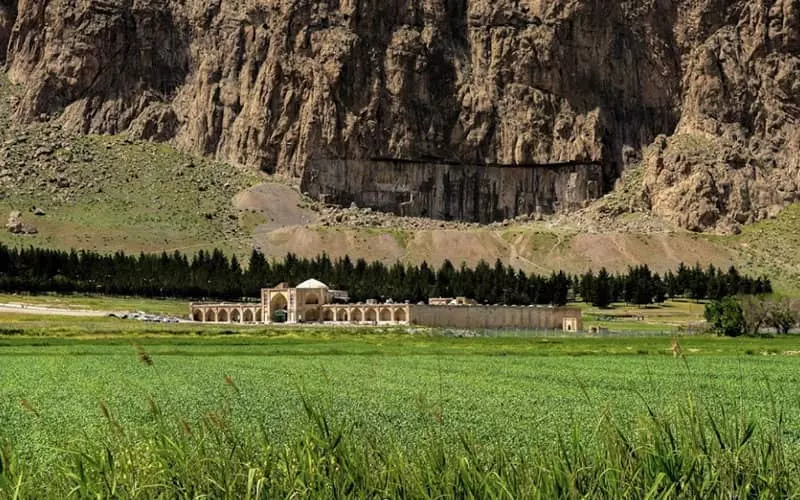
Unveiling the Bisotun Inscription
Carved into the sheer face of Mount Bisotun in 522 BC by order of Darius the Great, the Bisotun Inscription is a trilingual masterpiece, etched in Old Persian, Elamite, and Akkadian. This monumental declaration recounts Darius’s rise to power following a series of rebellions, glorifying his victories and extolling his virtues. The inscription’s significance extends beyond its historical narrative; it serves as a Rosetta Stone for linguists, enabling the decipherment of ancient languages.
Bisotun Mountain and Bisotun Reservoir
Covering an area of 1,650 hectares, the Bisotun complex possesses significant historical, natural, and environmental value. But what has made Bisotun famous worldwide is the inscription of Darius the Great dating back to 520 years before Christ.
To date, this complex has accommodated 28 registered works in national and world heritage, including the Hunter’s Cave, Mar Mar Cave, Bisotun Reservoir, Dark Mar Cave, Median Sanctuary, Balash Stone, Mehrdad the Arsacid Relief, Goudarz Relief, Farhad Carving, Ilkhanid Caravanserai, Bisotun Bridge, and more. These unparalleled and invaluable artifacts are considered important documents in the history of Iran.
It is interesting to note that within the vicinity of Bisotun Mountain, scattered pieces of limestone blocks are found, shaped into rectangular and square cubes. Similar limestone blocks can be seen in the semi-finished structures of the Sassanian era, such as the Farhad Carving and the Khosrow Bridge. In addition to the carving technique of these blocks, the mason’s marks are also in the Sassanian style.
Where is Bisotun?
Bisotun is located 30 kilometers northeast of Kermanshah, alongside the ancient road from Kermanshah to Hamadan. This historical site shines like a gem in the foothills of Bisotun Mountain in the city of Bisotun.
Address: Bisotun Historical Complex, Bisotun City, Kermanshah Province
History of Bisotun
Bisotun complex is considered one of the most important historical sites in the country, which has been the focus of attention of kings and rulers for various reasons. Among these reasons, mention can be made of its favorable climate and good geographical location, as well as its proximity to Mesopotamia. Interestingly, the Bisotun plain was situated near important transportation routes such as the road from Media to Babylon and the Silk Road, which itself indicates the reason for the attention of kings from various dynasties to it. Since Bisotun Mountain was on the path of caravans and military forces, the area was considered a strategic location for the assertion of power by Iranian kings.
This historical and ancient site includes artifacts from various periods from prehistory to post-Islamic times. The Hunter’s Cave and Mar Mar Cave from the prehistoric period, the Median Sanctuary from the Median period, the Bisotun Inscription and Relief from the Achaemenid period, the Statue of Hercules from the Seleucid period, the Balash Stone, Goudarz Relief, and Mehrdad the Arsacid Relief from the Parthian period, Bisotun Palace, Farhad Carving, Sassanian structures, and Sassanian Bridge (Khosrow Bridge) from the Sassanian period, Ilkhanid Caravanserai from the Ilkhanid period, Shah Abbas Caravanserai, Sheikh Ali Khan Zangeneh Inscription, and Bisotun Bridge (Safavid Bridge) from the Safavid period are among them.
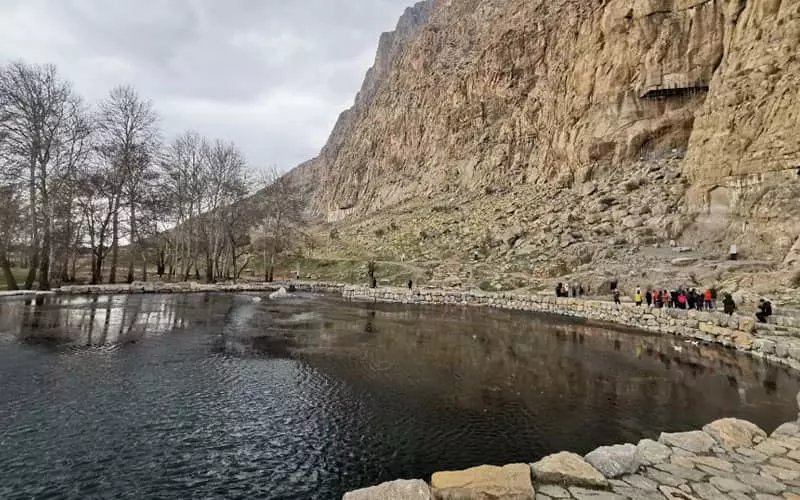
Reason for Naming Bisotun
Bisotun derives from the word “Baghestan,” meaning the abode of gods, and it is probable that its ancient name was Bagastana. Over time, Bisotun changed to “Bahistan” and later “Bahiston,” until after Islam, it was called “Behiston,” meaning the good pillar or the better pillar. Today, it is still pronounced as Bisotun. However, reading it as “Bi-stone,” meaning without a pillar, is incorrect and holds no validity.
Bisotun Mountain
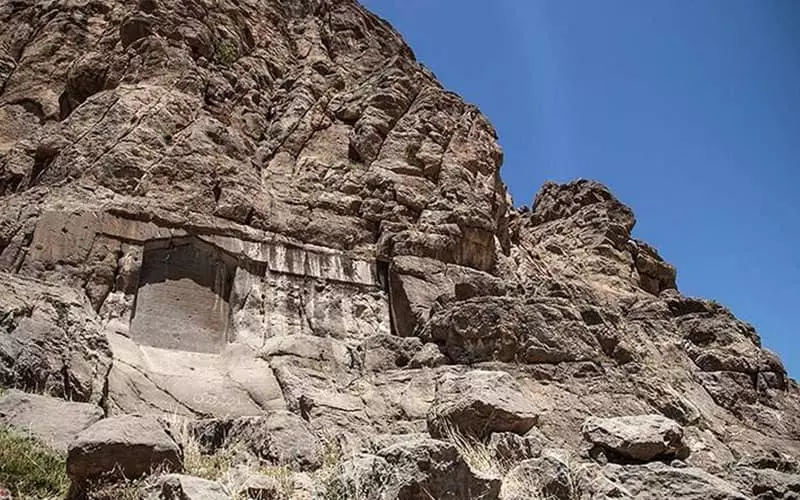
Bisotun Mountain, a tall limestone mountain in Harsin County, 30 kilometers from Kermanshah, besides the inscription of Darius the Great, has 28 historical works registered in the national heritage list.
During the Paleolithic period, Bisotun Mountain was the habitat of hunter-gatherer humans who used the caves in the southern foothills for seasonal settlement. The Hunter’s Cave was the first cave in Bisotun that was excavated for two weeks by American anthropologists in 1949, leading to the discovery of thousands of stone tools from the Middle Paleolithic period. During this excavation, bone remains of animals such as horses dating back approximately 40,000 to 70,000 years were also found. Among these remains, part of a human radius bone was discovered, possibly belonging to a Neanderthal or an early modern human of the Middle Paleolithic period. Additionally, in other caves of Bisotun Mountain like Mar Mar Cave, Dark Mar Cave, and Sun Cave, evidence of Neanderthal human habitation has been found.
Beside its historical aspects, Bisotun Mountain has had a significant influence on our literature and is remembered among Iranians as a sacred mountain. One of these influences can be observed in the epic of “Khosrow and Shirin” by Nizami Ganjavi, where the abundant love of Farhad for Shirin is mentioned. According to the story, Khosrow Parviz, one of the famous Sassanian kings who himself was in love with Shirin, tells Farhad that if he can carve Bisotun Mountain completely, he will allow him to marry Shirin. Khosrow Parviz, who did not expect this to happen, becomes concerned upon witnessing Farhad’s years of effort in carving the mountain and the progress of his work, and upon hearing the false news of Shirin’s death from his courtiers, he informs Farhad, leading to Farhad’s tragic death.
It might be interesting to know that Bisotun’s wall, with a width of 5000 meters, is one of the most technical rock walls in the world and is the fifth highest wall globally. It is also known as the “Everest of rock walls” and the tallest wall in Iran.
Bisotun Inscription
The Bisotun Inscription, dedicated to the victory of Darius the Great over the rebel Gaumata, is the most important artistic and historical work of the Achaemenid period and the oldest text in Iranian literature, thus considered one of the most important historical documents globally. Near this inscription, there are traces of stairs that apparently were used by masons to access the inscription site, and after finishing the work, they carved it to prevent access to the inscription and relief. This inscription is carved on limestone rocks, and traces of a brownish glaze can be seen on it, which has changed color over time. It appears that the masons covered it with this unknown glaze to enhance the durability of the inscription and relief.
The Bisotun Inscription, with a width of 7.8 meters and a length of 22 meters, is carved with cuneiform script in three languages: Old Persian, Elamite, and Akkadian (Neo-Babylonian) with chiseled script. The Old Persian text is displayed in five columns, with Ahura Mazda depicted as a human-faced figure at the top of this inscription. He wears a radiant crown, indicating his greatness and godliness.
The Elamite text is written in eight two-part columns, and the Akkadian text is written in one column. In addition to these three main texts, you can see 11 other small inscriptions on the rock related to Darius and his dynasty.
The beginning of this inscription introduces Darius and his lineage, which reads as follows:
“I am Darius the Great King, King of Kings, an Achaemenid. I am now king in Pars. My father was Vishtaspa; my father’s father was Arsames; my father’s father’s father was Ariaramnes; my father’s father’s father’s father was Teispes; my father’s father’s father’s father’s father was Achaemenes. From this line we are descended. Eight of my dynasty were kings before me; I am the ninth king. We have been kings for a long time.”
As the first four columns of the Old Persian text deal with the events of Darius’s reign, it holds significant historical value. The continuation of the inscription respectfully addresses Ahura Mazda and his forgiveness. Darius, along with introducing his 23 subject lands, registers and describes the battle against the rebels who claimed kingship in his first year of reign. Darius’s victories in 19 battles, the death of Cambyses, the revolt of Fravartiš, and his execution in Ecbatana, the rebellion of Gaumata and its suppression, Darius’s triumph over the Scythians, the establishment of peace and security in his vast empire, refraining from falsehood and defending truth, advising future kings, and more are documented in this inscription.

The Relief and Inscription of Darius at Bisotun
The Bisotun relief, with a length of 6 meters and a width of 3.20 meters, depicts Darius’s victory over Gaumata the Magian (the lying Bardia) and the capture of the rebels. The figure of Ahura Mazda is positioned above the heads of the captives, bestowing the ring of power upon Darius the Great.
The Bisotun relief depicts Darius’s victory over Gaumata the Magian
In addition to the symbol of Ahura Mazda, you see Darius the Great placing his left foot on the chest of Gaumata the Magian, who has fallen under his feet on the ground. One foot and two hands of Gaumata are sculpted as a gesture of supplication towards the upper figure. In this relief, Darius wears a long robe and a cone-shaped crown shining like a gem on the left side of the inscription. He raises his right hand in worship of Ahura Mazda.
The symbol of Ahura Mazda with a ring in his left hand is directly facing Darius, who also raises his right hand, indicating a prayer of blessing for Darius or his approval. Ahura Mazda wears a cylindrical hat with a circle featuring an eight-pointed star, just like the shape seen on Darius’s crown.
Nine prisoners, with bound hands and ropes around their necks, are tied together in a line behind Darius. The relief of Darius measures 180 centimeters, while the figures of the archer and spearman standing behind him reach about 150 centimeters, and the prisoners with a height of approximately 120 centimeters are depicted. These prisoners falsely claimed themselves as kings.
The Bisotun inscription and relief have suffered serious damage due to factors such as geological erosion, rain, and wind, human destruction, and ignorance.
The Statue of Hercules
The Statue of Hercules is one of the attractions of the historical complex of Bisotun, which always attracts many tourists. This statue, dating back to the Seleucid-Parthian period, was discovered in February 1958 when workers were busy excavating and leveling the road to build a new highway from Hamedan to Kermanshah. The construction of the statue is estimated to date back to 153 BCE, corresponding to the reign of Mithridates I of Parthia and the late Seleucid rule.
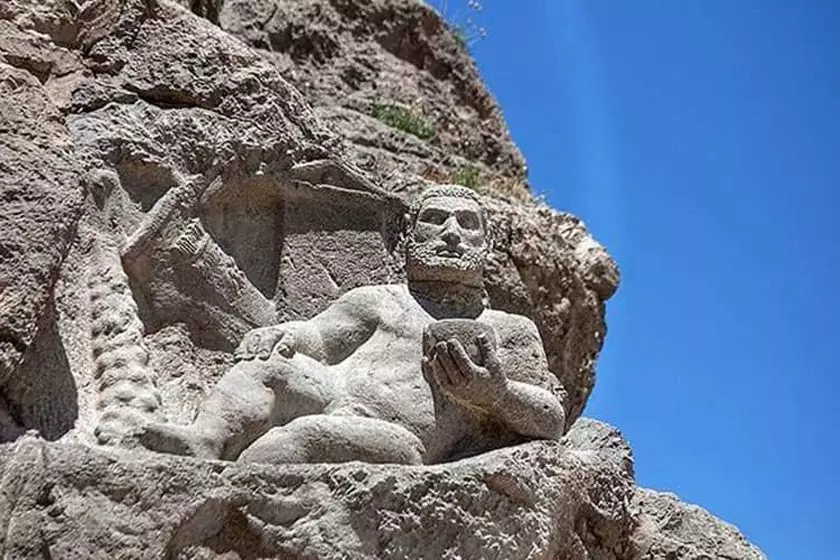
At that time, Hercules was one of the most beloved gods, and hence many clay and stone sculptures of him were made, the most famous of which in Iran is the stone statue of Hercules located beside the “East-West” royal road of the Silk Road. This statue depicts a strong-bodied figure with curly hair and beard resting on the skin of a lion. The statue of Hercules is placed on a platform approximately 20 meters long. While holding a bowl in his left hand, he lies semi-reclined on his left side, placing his right hand on his right leg and his right leg on his left leg.
In addition to the ancient Greek inscription engraved on the stone behind the statue, other motifs such as an olive tree catch the eye, with a bowman and an archer hanging from its branches. A cone-shaped mace is also carved beside this tree, which is more prominent than other reliefs.
A lion relief is seen under the torso of Hercules, carved from stone and connected to the mountain from behind, measuring approximately two meters from head to tail and 114 centimeters in height.
Planning Your Bisotun Adventure
The ideal time to visit Bisotun is during the spring (March-May) or autumn (September-November) when the weather is pleasant and sunny. Allow at least two days to fully explore the town and its attractions. Accommodation options range from traditional guesthouses to modern hotels, catering to diverse budgets.
Bisotun is easily accessible by road from Kermanshah, the nearest major city. Regular buses connect Bisotun to Kermanshah and other nearby towns.
Bisotun Palace
The ruined and unfinished Bisotun Palace is located right in front of the Bisotun inscription and is attributed to King Khosrow Parviz of the Sasanian era. According to archaeological excavations conducted periodically since 1976, this palace, which had only its surrounding walls constructed, remained unfinished due to certain reasons and later was turned into a caravanserai. Although the caravanserai was destroyed due to an earthquake, a village was built on it during the Qajar period.
The Ilkhanid Caravanserai
The Ilkhanid Caravanserai is another historical monument in the vicinity of Bisotun, located downstream of the Farhad Tarash, which was built on the remains of the unfinished Sasanian palace.
To construct this caravanserai, materials such as bricks, rubble stone, and gypsum mortar were used, and it was built on the remains of the stone walls of the Sasanian palace. Besides the central courtyard, this caravanserai had 64 chambers and a small mosque. Apparently, this place was destroyed and lost its function due to a severe earthquake. However, remnants of its arches still exist.
During the Timurid period, scattered constructions were made on this building, evidenced by multiple furnaces at various depths within the structure. In the Safavid era, the materials of this building were reused to construct Shah Abbas Caravanserai.
Farhad Tarash
Farhad Tarash, a large and semi-unfinished rock carving in the west of Darius the Great’s inscription, on a wall with a height of 36 meters and a length of 200 meters, also known by other names such as “Firay Tash,” “Faratash,” or “Takht-e Farhad.” This historical work was registered as a national heritage of Iran in 2001.
Abraham Jackson, who visited this site in 1903, considered this empty site suitable for recording the future victories of Darius the Great. Some other archaeologists believe that the purpose of carving this part of the mountain was to depict a significant historical event by Khosrow Parviz, the Sasanian king.
However, some recent experts speculate from the stone blocks, column shafts, and semi-finished bases at the foot of the mountain and the surrounding areas that Farhad Tarash was originally a quarry for extracting stones used in the construction of the Bisotun structures. The semi-unfinished palace of Khosrow Parviz is only a few hundred meters away, which strengthens the likelihood of this theory.
Farhad Tarash holds a special place in Persian literature, as people consider it the work of Farhad the Mountain Carver, who, due to his sweet love, embarked on this task, as depicted in the verses of poets like Nizami Ganjavi.
The Belash Stone
There is an irregular quadrilateral stone slab in the foothills of Mount Bisotun, reaching a height of 2.5 meters, with low-relief carvings on three of its sides. This valuable artifact was listed in Iran’s national heritage in 2001.
On the middle side of this stone slab, a carving belonging to “Belash” of the Arsacid kings is visible in full-face view. In addition to a belt around his waist and a necklace, he wears a loose skirt. He has a face with a beard and mustache, and long hair adorned with a decorative headband. In his left hand, this king holds a bowl, while his right hand is extended towards a long torch-like object, as if pouring something into it.
Since the end of the inscription has faded, it is not clear which Belash the mentioned relief belongs to.
On the left side of this stone slab, there is a person dressed similar to Belash who apparently is walking towards the relief of Belash; meanwhile, he raises his right hand and holds something in his other hand. On the right side of the relief of Belash, there is a depiction of a third person wearing knee-length clothing.
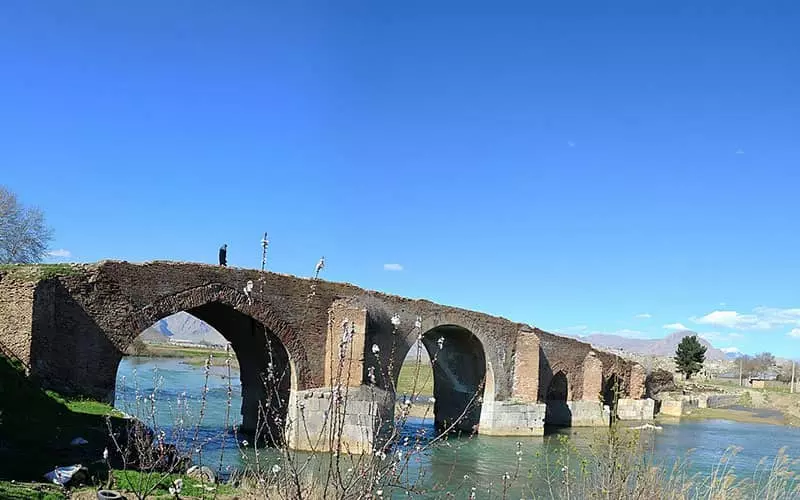
Bisotun Pool
Bisotun Pool is a blue spring whose water collects in a pond, and this pond, not very large, has been one of the reasons for human settlement in this area from the Paleolithic era to the present day. Interestingly, passing caravans on the route from western Iran to Mesopotamia used to stop by Bisotun Pool. It’s noteworthy that many historical artifacts have formed around this ancient site; so much so that the beautiful inscription and reliefs of Darius, the Arsacid reliefs, the statue of Hercules, the Hunter’s Cave, the Median shrine, Shah Abbas Caravanserai, and others can be seen from the vicinity of the pool.
This historical pool, located at an altitude of 1320 meters above sea level, has tasteless water and is used for irrigating the fields in the area. Bisotun Pool was registered nationally in 2001 and was listed as one of Iran’s natural heritages in 2009. Poplar trees reaching up to the sky, picturesque nature, and historical artifacts around the pool are among the factors that have turned it into one of the most beautiful pools in Iran.
Madai Temple
The Madai Temple is another national heritage site located in the historical complex of Bisotun, situated beneath the Darius the Great inscription. This temple consists of a platform measuring 10.5 meters in length, seven meters in width, and 1.5 meters in height, constructed with uncut and dry-laid stones and divided into two sections through a seven-meter-long and 1.5-meter-wide corridor. At the end of this corridor lies a chamber surrounded by a mountain cleft and a wall. Approximately 60 years ago, a German expedition, during their survey and excavation of this platform, introduced it as a Madai period sanctuary. During the excavation on and around the platform, pottery dating back to the early first millennium BCE was discovered.
Madai Fortress
The Madai Fortress historical site is located in the northwest of the Bisotun complex, which, according to archaeological excavations in 1966, had rectangular towers and ramparts. The fortress walls were constructed using dry-laid stones of various sizes. Since the pottery found in this structure resembles those discovered in Nushijan Malayer and Gudin Tepe Kangavar, it is attributed to the Medes period. Additionally, the discovery of a bronze breastplate pin dating back to the 8th century BCE strengthens this theory.
Archaeologists believe that the establishment of this structure is related to the Darius relief and suggest that Gomatesh Magus and his associates were defeated by Darius in this location.
During an excavation conducted in 2002, pottery artifacts from various historical periods such as the Neo-Elamite, Iron Age, Achaemenid, Parthian, and Islamic periods were found, indicating the peak of the fortress’s prosperity during the Medes period.
Goudarz Stone Relief
The Goudarz Stone Relief is a historical artifact from the Parthian period, registered nationally in 2001, depicting the victory of Goudarz II over Mehrdad. Mehrdad was a Parthian prince who was raised in the court of the Roman Empire, while Goudarz ruled over Iran from 38 to 51 CE. In this stone relief, which portrays a somewhat obscure battle scene, three armored warriors on horseback are noticeable, with the central figure belonging to the King of Iran, Goudarz. In this depiction, “Nike” (the goddess of victory) crowns Goudarz, while he attacks another rider (Mehrdad II) with a spear, knocking him off his horse.
Goudarz’s attendant is seen on horseback with a spear in hand, positioned behind the king. Another rider is also visible below this relief. There is a Greek inscription on the stone relief introducing Goudarz as the “King of Kings, son of Gaius,” and Mehrdad as “Mehrdad the Persian.”
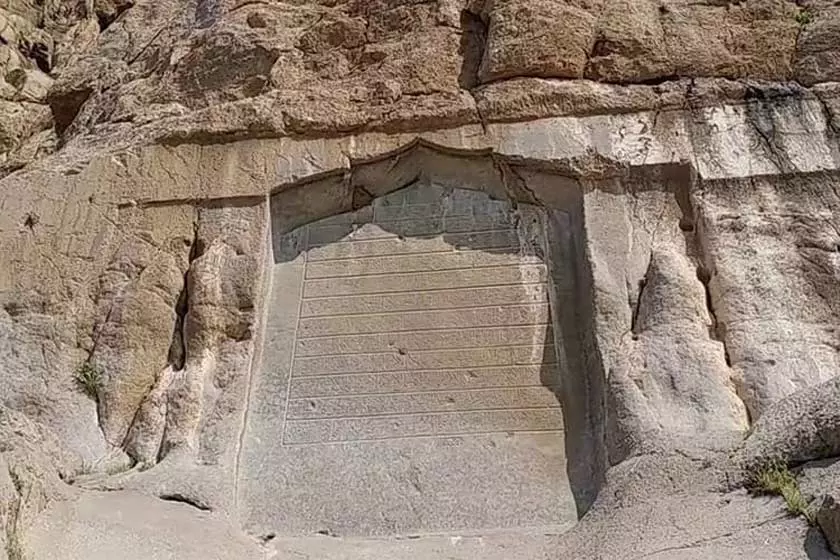
Mehrdat Parthian Relief
The relief of Mehrdad is one of the oldest surviving relics from the time of the Arsacids, with significant historical value. This artifact, which was likely carved between 123 and 110 BCE, is located just below the Darius the Achaemenid inscription.
The Mehrdad relief at Bisotun depicts the transfer of power from him to the satraps (local governors), each standing in line behind the other, with half-profile faces turned towards Mehrdad. There is a Greek inscription above each of these prominent figures, introducing them. The first person is Goudarz I, a satrap who later becomes Mehrdad’s successor. The name of the second person is completely erased, probably one of the Parthian princes. The third person is named Mithradates, referred to in the inscription as “Pepi Tominus,” meaning trustworthy king. The fourth person is Kufasats.
This relief has not only suffered natural damage over time but also, Sheikh Ali Khan Zanganeh, who held the position of prime minister under Shah Suleiman Safavid, destroyed parts of it for his own memorial stone inscription.
Parthian Temple
There is a historical artifact in the north of the Darius relief, believed by experts to be a temple from the Parthian period. This structure consists of two stone platforms connected to each other by a series of stone steps. A circular cavity inside these platforms is visible, which some people believe was used as a fire altar in religious ceremonies.
Shah Abbas Caravanserai at Bisotun
The Shah Abbas Caravanserai is another unique historical landmark of Bisotun, located on the ancient Kermanshah-Hamadan road, and was registered as a national heritage site in Iran in 1974.
This caravanserai, covering an area of over 6,000 square meters, was built in the style of Iranian caravanserais during the Safavid era. The construction of this structure likely began under the order of Shah Abbas I of the Safavid dynasty and apparently completed by the efforts of Sheikh Ali Khan Zanganeh, according to the inscription on its main entrance.
During the reign of Naser al-Din Shah, the caravanserai underwent restoration, and during the Pahlavi era, it was used as a grain warehouse. After the Islamic Revolution, it was under the control of the Prison Administration for 17 years until finally being reclaimed by the Cultural Heritage Organization for restoration.

The Shah Abbas Caravanserai has been converted into a traditional five-star hotel.
On each side of this caravanserai, there are four iwans, two stone platforms, and seven vaulted chambers, with a tower at each of the four outer corners, one tower on the northwest side, and the remnants of a tower on the southeast side remaining. After the entrance, eight domed chambers are visible, including sections such as the royal seating area.
The conversion of the Shah Abbas Caravanserai into a hotel was completed in 2014, allowing this historical site to begin its operation as a traditional five-star hotel with a capacity of accommodating 100 guests.
Sheikh Ali Khan Inscription
Sheikh Ali Khan, who was initially the ruler of Kermanshah, undertook numerous civil engineering projects in this region. Later, he became the Prime Minister of Shah Abbas II and then Shah Suleiman Safavid and was trusted to the extent that he bestowed upon himself the title of Etemad al-Sultanah.
The Sheikh Ali Khan inscription, registered nationally in 2001, is, in fact, his endowment document inscribed on the relief of Mehrdad II in the Bisotun mountain range, and the destruction of this historical artifact from the Arsacid period followed.
This vaulted chamber, measuring 363 cm in length and 276 cm in width, contains 15 lines inscribed in thuluth script. The inscription begins with the name of God, and it is stated that Sheikh Ali Khan allocated six dong of Nahreh Qareh Veli and Chambatan estates in 1093 AH to the Bisotun Caravanserai and four dong to the Fatemi Sayeds. The calligraphy of the Sheikh Ali Khan inscription was done by a famous Safavid calligrapher named Mohsen Emami.
Remains of the Parthian City
The remains of an ancient city, measuring 800 meters in length and 300 meters in width, are located in the northeast of the Bisotun spring, believed by archaeologists to belong to the Parthian period. It seems that this residential area was associated with other Arsacid-era artifacts in Bisotun (such as the relief of Goudarz, Mehrdad II, and Balash) and was constructed simultaneously with them.
Sasanian Bridge
The Sasanian Bridge, also known as the Khosrow Bridge, spans 152.80 meters over the Gamasab River, located two kilometers from the city of Bisotun. Based on the construction technique, the surface carving of the stones, and the signs of masonry, as well as Khosrow Parviz’s interest in construction, it can be concluded that this historical monument dates back to the Sasanian period. Some experts believe that this bridge was part of a Sasanian dam.
The bridge has 9 arches and 10 piers, with each pier measuring 3.14 meters in length and 2.7 meters in width. The piers are constructed with hexagonal plans, made of plaster and carved stone, with the intervals between the piers filled with lime mortar and river pebbles. The bridge is built on a stone bed, not only preventing the riverbed from eroding but also regulating the water level. Currently, only the supports remain, and in recent years, local people have placed metal structures on the stone bases for crossing.
Bisotun Bridge
The Bisotun Bridge, registered as a national heritage site in Iran, spans the Dinurab River and is known by various names, including the Shah Abbas Bridge, Safavid Bridge, Old Bridge, Naderabad Bridge, and Dinurab Bridge. This bridge is 144 meters long and, since it was built in the late Sasanian period, it is attributed to Khosrow Parviz.
According to evidence, the bridge’s foundations were laid in the late Sasanian period, much like many other unfinished Sasanian structures in Bisotun, and were completed in the 4th century AH. In the Ilkhanid period, the fifth arch of the bridge underwent reconstruction. The restoration of the bridge’s façade and the fourth vault occurred during the Safavid and Pahlavi periods, respectively.
This five-arch bridge is made of brick with gypsum mortar, except for the fourth arch, which has an elliptical vault. All the vaults of the bridge are groin vaults. Except for the side supports, all the supports of the Bisotun Bridge have hexagonal plans. The middle part of the supports is cuboid-shaped, with triangular buttresses on the sides. The bridge supports are made of stone and gypsum mortar, and its passageway is made of river pebbles.
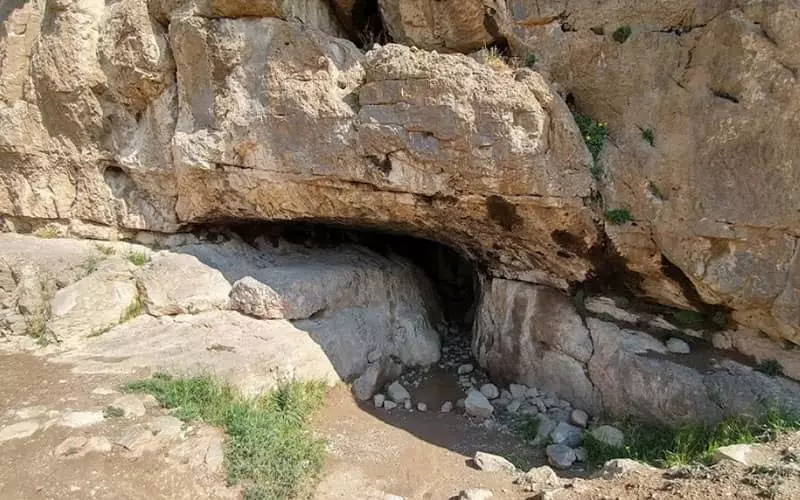
Bisotun Caves
The Bisotun Caves include Mar Kharal, Shikarchiyan, Mar Tarik, Mar Doodar, and Mar Aftab, which represent the oldest artifacts from the Paleolithic periods in Bisotun.
Mar Khar: This cave, also known as the Bisotun Cave, is located just above the Hercules statue and likely served as a temporary shelter for hunters who used it for skinning game and hiding from wild animals. The Mar Khar Cave was registered as a national heritage site in Iran in 2001.
In excavations and explorations carried out in the Shikarchiyan Cave, bone tools and stone tools were discovered, along with bones of deer, gazelles, wild horses, wild cows, and deer, as well as a human ulna bone dating back to 40,000 to 70,000 years ago, belonging to a Neanderthal.
Mar Tarik: Located northwest of Mar Khar Cave, this cave contains stone artifacts such as scrapers, burins, chips, blades, etc., from the Middle Paleolithic Mousterian industry. Bones of animals such as fish, bats, mice, and insectivorous mammals were also found in this cave.
Mar Aftab: Between Mar Tarik and Mar Doodar caves, there is another cave that apparently served as a seasonal residence during the Paleolithic period. Some stone tools and a bone tool were discovered in this cave. With an area of approximately 160 square meters, the main cavity is separated from the rear part of the cave by a stalagmite stack.
Mar Doodar: This cave, considered the highest cave in Bisotun, with a height of about one to three meters, is located northeast of the Shikarchiyan Cave. Mar Doodar contains artifacts from the Paleolithic periods, and due to having two entrance openings, it is called Mar Doodar or the Dual Cave. The main opening of the cave overlooks a steep and narrow valley, and the other opening leads to a path that connects to Mar Aftab and Mar Tarik caves.
Bisotun Historical Complex Facilities and Visiting Conditions
The Bisotun historical complex offers facilities such as parking, restroom, prayer room, handicrafts stalls showcasing Kermanshah’s local crafts and souvenirs, restaurants, and beverage stands for tourists.
Since the Behistun inscription and relief of Darius the Great are currently undergoing restoration at the time of writing this article (winter 2020), visiting them is not possible, and tourists can observe them from the eastern part of Bisotun.
Entry of vehicles into the Bisotun compound is prohibited, and activities such as setting up tents, making fires, etc., are not allowed inside. Sports activities such as rock climbing, parachuting, etc., in the Bisotun mountains require permission from the Bisotun World Heritage Site authorities.
As mentioned, the Shah Abbas Caravanserai in Bisotun has now been converted into a hotel, and therefore, it cannot be visited.
If you have visited the Bisotun historical complex before, you can share your location and experience for our users below.
Frequently Asked Questions:
Where is Bisotun located?
Bisotun is located 30 kilometers northeast of Kermanshah.
What is the most important monument in Bisotun?
Bisotun is internationally renowned for the Behistun inscription and relief of Darius the Great from the Achaemenid period.
What historical monuments are located in Bisotun?
There are numerous historical monuments in Bisotun, including the Behistun inscription and relief of Darius, Bisotun spring, Madayn temple, Balash stone, Goudarz relief, Farhad Tarash, Ilkhanid Caravanserai, Shah Abbas Caravanserai, Bisotun Bridge, etc.
To which historical periods do the ancient monuments in Bisotun belong?
The historical artifacts in the Bisotun historical complex range from the prehistoric period to post-Islamic eras.
Bisotun: A Cultural Tapestry
Bisotun’s rich cultural heritage is evident in its vibrant festivals, traditional handicrafts, and delectable cuisine. Immerse yourself in the local culture by attending the annual Bisotun Inscription Festival, held in September, or by purchasing exquisite handmade souvenirs from local artisans. Savor the flavors of Bisotun’s cuisine, renowned for its hearty stews, freshly baked bread, and sweet pastries.
Bisotun beckons travelers with its blend of historical treasures, natural wonders, and cultural vibrancy. From deciphering ancient inscriptions to conquering mountain peaks, Bisotun promises an unforgettable adventure that will leave you yearning for more.

